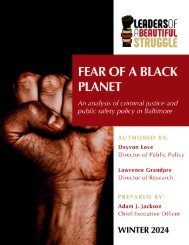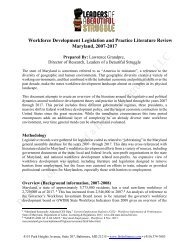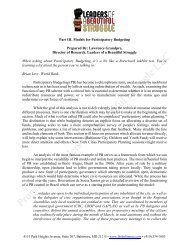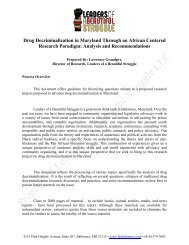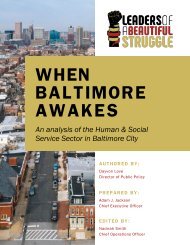The Communal Impacts of Drug Criminalization in Maryland
This project attempts to reframe the harms of drug criminalization. Influenced by African-Centered Research Methodologies, we engaged in a literature review and qualitative research of the communal impacts of drug decriminalization in Maryland, with a specific focus on Baltimore.
This project attempts to reframe the harms of drug criminalization. Influenced by African-Centered Research Methodologies, we engaged in a literature review and qualitative research of the communal impacts of drug decriminalization in Maryland, with a specific focus on Baltimore.
Create successful ePaper yourself
Turn your PDF publications into a flip-book with our unique Google optimized e-Paper software.
works. Specifically, we looked at how literature <strong>in</strong>corporates the role <strong>of</strong> Black civil society <strong>in</strong>stitutions <strong>in</strong><br />
social capital research.<br />
We used Arksey and O’Malley’s (2005) five-stage scop<strong>in</strong>g review framework (44), with report<strong>in</strong>g guided<br />
by the PRISMA extension for scop<strong>in</strong>g reviews checklist and explanation (PRISMA-SCr): (1) research<br />
question development, (2) literature search, (3) study selection, (4) data chart<strong>in</strong>g and extraction, and (5)<br />
data analysis and narrative synthesis. For full description <strong>of</strong> the methods, see appendix.<br />
Scop<strong>in</strong>g Review F<strong>in</strong>d<strong>in</strong>gs<br />
Research that exam<strong>in</strong>es the impact <strong>of</strong> drug crim<strong>in</strong>alization on the social <strong>in</strong>frastructure and civic<br />
<strong>in</strong>stitutional fabric <strong>of</strong> communities faced with high levels <strong>of</strong> drug addiction and crim<strong>in</strong>alization is<br />
m<strong>in</strong>imal. A few papers outl<strong>in</strong>ed the role <strong>of</strong> drug crim<strong>in</strong>alization on community-level aspects. Out <strong>of</strong> 46<br />
articles related to social capital and drug crim<strong>in</strong>alization, 23 described social capital relationships local to<br />
the community, 11 described social capital externally l<strong>in</strong>ked to communities, and 12 described both<br />
<strong>in</strong>ternal and external relationships <strong>of</strong> social capital. Five studies <strong>in</strong>corporated participatory or<br />
community-<strong>in</strong>formed methods.<br />
In the review <strong>of</strong> social capital relationships, there was an emphasis on the disruption <strong>of</strong> family<br />
relationships and m<strong>in</strong>imal research on the impact <strong>of</strong> drug crim<strong>in</strong>alization on the community environment<br />
(45–52). <strong>The</strong>re was little research on the relationship between drug crim<strong>in</strong>alization and the social erosion<br />
<strong>of</strong> community sources <strong>of</strong> support, like faith-based organizations, and more research on sources <strong>of</strong> support<br />
that operated outside <strong>of</strong> community control, such as government and non-pr<strong>of</strong>it drug treatments (53–62).<br />
This focus was on social capital by def<strong>in</strong><strong>in</strong>g it <strong>in</strong> terms <strong>of</strong> the relationship with community members who<br />
use drugs with treatment-provid<strong>in</strong>g <strong>in</strong>stitutions. <strong>The</strong> research <strong>of</strong>ten framed sources <strong>of</strong> support external to<br />
impacted communities as vehicles for success, rather than on study<strong>in</strong>g how structural racism and other<br />
modes <strong>of</strong> oppression destabilizes communal conditions and <strong>in</strong>digenous forms <strong>of</strong> social capital. Although<br />
research and practice seek to address the material suffer<strong>in</strong>g caused by hyper-<strong>in</strong>carceration and addiction,<br />
20 <strong>of</strong> 55




